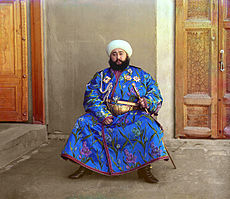- Manghit
-
For the town in Kyrgyzstan, see Mangit, Kyrgyzstan.
The Manġhud (Mangghud) or Mangudai (Mongolian: Mangudai) were a Mongol tribe of the Urud-Manghud federation. They established the Nogai Horde in the 14th c. and the Manghit Dynasty to rule the Emirate of Bukhara in 1785. The clan name was used for Mongol vanguards as well. Their descendants live in several regions of the former Mongol Empire.
Contents
Manghuds in the Mongol Empire
See also: Nogai Khan and Mongol invasion of EuropeAccording to ancient sources, they were derived from the Khiyad Mongols. The Manghuds and the Uruuds were war-like people from the Mongolian plateau. Some notable Manghud warriors supported Genghis Khan (1162–1227) while a body of them resisted his rise to power. When the Mongol Empire began to expand westward, the Manghud people were spread westward into the Middle East along with many other Mongol tribes. In the Golden Horde, the Manghuds supported Nogai (d.1299) and established their own semi-independent horde from the khans in Sarai.[1] After Nogai's death in 1299 AD, the majority of Manghud warriors joined the service of Tokhta Khan. Their chieftain Edigu, the powerful warlord of the Golden Horde, officially founded Nogai Horde or Manghit Horde in the 14th-15th century. Turkish historians would record their tribal name as Manghit or Nogais, as opposed to the original Manghud or Mangudai.
Military unit of the Mongols
The mangudai or mungadai were military units of the Mongol Empire, but sources differ wildly in their descriptions. One source states that references to Mongol light cavalry "suicide troops" date back to the 13th century.[2] However, a United States Army author believes that Mangudai was the name of a 13th-century Mongol warlord who created an arduous selection process to test potential leaders.[3] The term is used by element of the United States Army as a name for multi-day tests of Soldiers' endurance and warrior skills.[4]
The Travels of Marco Polo uses the word Meng-Gu-Dai as the name of a person: "The (Mongol) Emperor ordered Meng-Gu-Dai to invade Si-Fan with 6000 men."[5]
Nogai Horde
Main articles: Nogai Horde and Nogai peopleThe Nogais protected the northern borders of Astrakhan and Crimean khanates, and through organized raids to the northern steppes prevented Russian and Lithuanian settlements. Many Nogais joined the service of Crimean khan. Settling there, they contributed to the formation of the Crimean Tatars. However, Nogais were not only good soldiers, they also had considerable agricultural skills. Their basic social unit was the semi-autonomous 'ulus' or band. But Nogais were proud of their nomadic traditions and independence, which they considered superior to settled agricultural life.
At the beginning of the 17th century, the Kalmyks or the Oirats, migrated from the steppes of southern Siberia on the banks of the Irtysh River to the Lower Volga region about 1630. The Kalmyks expelled the Nogais who fled to the plains of northern Caucasus and to the Crimea under the Ottoman Empire.
Manghit Dynasty
In the 18th century the basins of the Amu Darya and Syr Darya passed under the control of three Uzbek khanates claiming legitimacy in their descent from Genghis Khan. These were, from west to east, the Qunggirats based on Khiva in Khwārezm (1717–1920), the Mangits in Bukhara (1753–1920), and the Mings in Kokand (Qǔqon; c. 1710–1876).
The Manghit dynasty was founded by an Uzbek family that ruled the Emirate of Bukhara from 1785 to 1920. Manġit power in the Khanate of Bukhara began to grow in the early 18th century, due to the emirs position as ataliq to the khan. The family effectively came to power after Nader Shah's death in 1747, and the assassination of the ruling Abulfayz Khan and his young son Abdalmumin by the ataliq Muhammad Rahim Bi.[6] From the 1750s to the 1780s, the Manġits ruled behind the scenes, until the emir Shah Murad declared himself the open ruler, establishing the Emirate of Bukhara. The last emir of the dynasty, Mohammed Alim Khan, was ousted by the Russian Red Army in September, 1920, and fled to Afghanistan. The dynasty descends from the great Mongol khans of the Golden Horde.
The Manghit dynasty issued coins from 1787 up until the Soviet takeover.[7]
List of Emirs of the Manghit Dynasty (1785–1920)
- Shah Murad Khan (1785 - 13 December 1799)
- Haydar Tura Khan (13 December 1799 - January 1826)
- Husayn Khan (January - March 1826)
- 'Umar Khan (March - 22 March 1826)
- Nasr Allah Bahadur Khan (22 March 1826 - 21 September 1860)
- Muzaffar ad-Din Bahadur Khan (23 September 1860 - 12 November 1885)
- 'Abd al-Ahad Khan (12 November 1885 - 9 December 1910)
- Mohammed Alim Khan (10 December 1910 - 30 August 1920)
Descendants
The Manghuds live as parts of Khalkha of Mongolia and Baarin banner in Inner Mongolia now.
Their descendants Nogai and Karakalpak people live in Dagestan and Khorazm. And the Manghits are also found among the Tatars in Russia, the Bashkirs and the Kazakhs.
References
- ^ A.V.Vernadsky - The Mongols and Russia
- ^ Chambers, James (2003). The Devil's Horsemen: The Mongol Invasion of Europe. Edison, New Jersey: Castle Books. ISBN 978-0-7858-1567-9.
- ^ Lt. Col. Edward F. Dorman III (Summer 2004). "Staff forges Warrior Ethos during Mangudai II". Blackjack Provider 2: 4. http://www.bragg.army.mil/COSCOM/SUBS/Summer%202004_Provider2.pmd.pdf. Retrieved 2006-04-15.[dead link][dead link]
- ^ Pfc. Chris McCann (2005-09-22). "Mungadai challenges 2-71 Cav officers". Fort Drum Blizzard Online. http://www.drum.army.mil/sites/postnews/blizzard/blizzard_archives/news.asp?id=8&issuedate=9-22-2005. Retrieved 2008-04-05.[dead link]
- ^ Travel Asia - 'The (Mongol) Emperor Ordered Meng-Gu-Dai To - Page 133 of 1350
- ^ Soucek, Svat, A History of Inner Asia, (Cambridge University Press:2000), page 180.
- ^ P. Donovan, The Coinage of the Mangit Dynasty of Bukhara The Coinage of the Mangit Dynasty of Bukhara, 'ANS Magazine' Vol. 6/1 (Spring 2007).
External links
See also
Categories:- Military history of the Mongol Empire
- History of Kazakhstan
- History of Mongolia
- History of Uzbekistan
- History of Tajikistan
- Mongolian dynasties
- Ethnic Uzbek people
Wikimedia Foundation. 2010.

